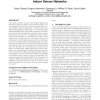Free Online Productivity Tools
i2Speak
i2Symbol
i2OCR
iTex2Img
iWeb2Print
iWeb2Shot
i2Type
iPdf2Split
iPdf2Merge
i2Bopomofo
i2Arabic
i2Style
i2Image
i2PDF
iLatex2Rtf
Sci2ools
IPSN
2010
Springer
2010
Springer
Practical modeling and prediction of radio coverage of indoor sensor networks
The robust operation of many sensor network applications depends on deploying relays to ensure wireless coverage. Radio mapping aims to predict network coverage based on a small number of link measurements. This problem is particularly challenging in complex indoor environments where walls significantly affect radio signal propagation. Nevertheless, we show that it is feasible to accurately predict coverage through a two-step process: a propagation model is used to predict signal strength at a recipient node, which is then mapped to a coverage prediction. Through an in-depth empirical study, we show that complex models do not necessarily produce accurate estimates of signal strength: there is an important tradeoff between model accuracy and the number of parameters that must be estimated from limited training data. We find that the best performance is achieved by a family of models which classify walls based on their attenuation into a small number of classes and develop an algori...
| Added | 12 Aug 2010 |
| Updated | 12 Aug 2010 |
| Type | Conference |
| Year | 2010 |
| Where | IPSN |
| Authors | Octav Chipara, Gregory Hackmann, Chenyang Lu, William D. Smart, Gruia-Catalin Roman |
Comments (0)

